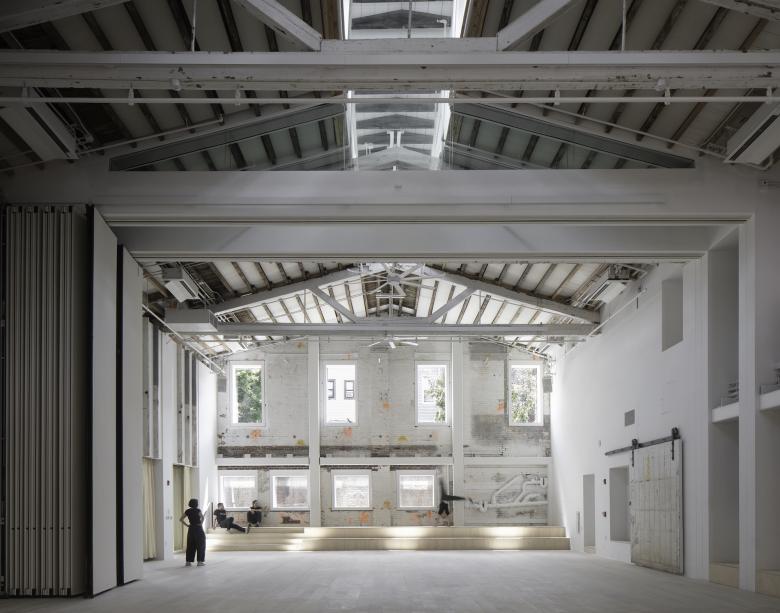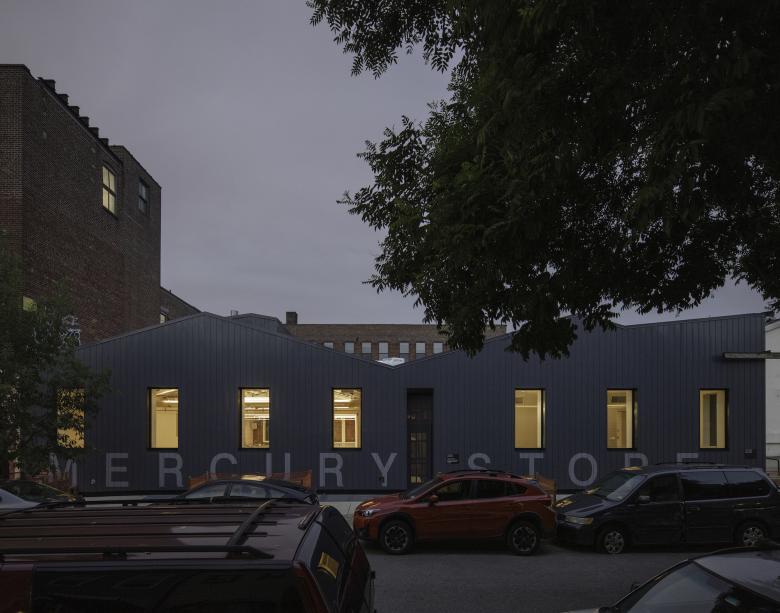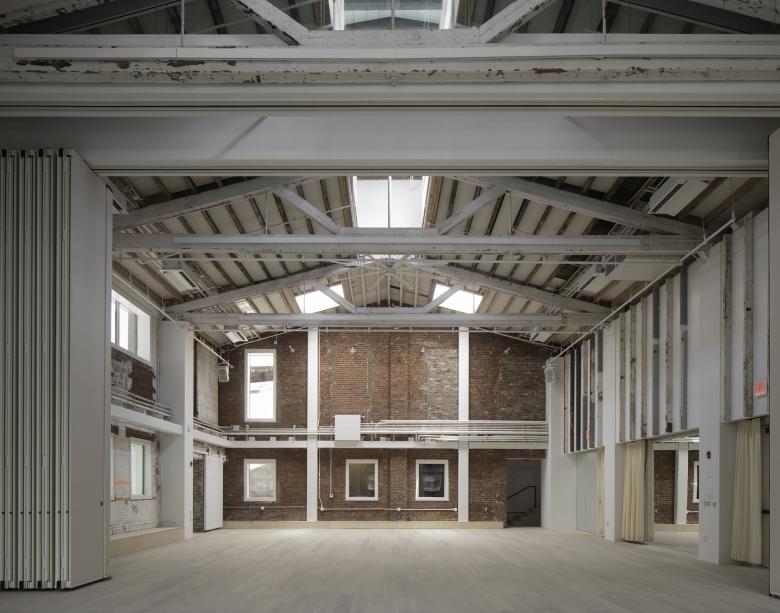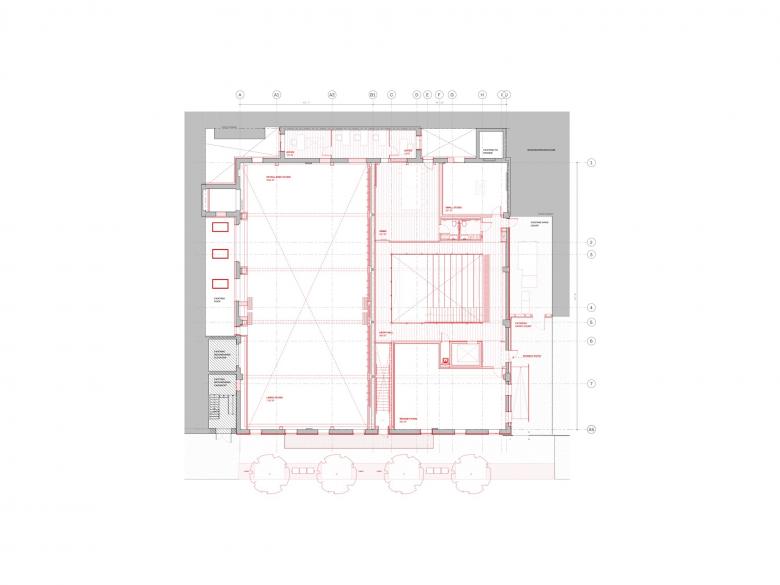US Building of the Week
Timber Adaptive Reuse Theater
CO Adaptive
1. 8月 2022
Photo: Naho Kubota
The Gowanus Canal in Brooklyn is turning from an infamous Superfund site into a cultural district where old industrial buildings are being transformed into performance venues. These include the new home for Powerhouse Arts designed by Herzog & de Meuron and CO Adaptive's transformation of a metal foundry into the Mercury Store, a new space for theater artists. The architects at CO Adaptive answered a few questions about their project.
Client: Mercury Store
Architect: CO Adaptive
MEPS Engineer: ABS Engineering
Structural Engineer: ADOF Structural Engineers
Acoustical Designer: Charcoal Blue
Lighting Consultant: SDA Lighting
General Contractor: Yorke Construction
Signage and Wayfinding Consultant: TwoTwelve
Sprung-wood Flooring Consultant and Fabricator: Hudson Scenic
Photo: Naho Kubota
What were the circumstances of receiving the commission for this project?We were invited to submit a proposal because we had completed a project of a similar program in Greenpoint, Brooklyn some years prior. The previous project entailed the conversion of an existing contractors workshop into a theatrical space and practice studios. CO Adaptive began the project soon after the client, the Mercury Store, purchased the building in 2017. Dating to 1902 and located in Brooklyn’s Gowanus Canal district, it had three previous lives: first, as the Royal Metal Furniture Company foundry; next, as a warehouse and storage facility; and, just prior to this renovation, as highly compartmentalized art studios and office space. Historically home to heavy industry, Gowanus is currently undergoing a vigorous transformation catalyzed by remediation efforts and substantial rezoning that allows for denser residential, commercial, and cultural sites.
Photo: Naho Kubota
Please provide an overview of the project.Brooklyn-based architectural practice CO Adaptive Architecture has transformed a 12,700-square-foot former metal foundry, previously used as offices, into The Mercury Store, a new, light-filled developmental space for theater artists. This adaptive reuse project updates and opens the original double A-frame, timber-and-brick building by repurposing removed elements as the basis for new architectural features. Wood is the project’s dominant material: old longleaf pine timber is reconstituted, while new insertions are made from cross-laminated timber (CLT), an innovative product that has a negative carbon footprint, compared to carbon-emitting materials like steel and concrete, therefore meeting CO Adaptive’s low-carbon design commitment. The project represents the first use of CLT on a fully commercial building in New York City.
Photo: Naho Kubota
What are the main ideas and inspirations influencing the design of the building?Our client came to us with the desire to create an open, light-filled space that was classic in its clarity and authentic to the building's character and inherent qualities. Their objectives included the aspiration to understand the wayfinding upon entry, which was very counter to the state in which they purchased the building: a dark labyrinth of rooms and hallways. Lastly, it was important to them that the building have a social center — a space to serve as the connecting core between the rehearsal studios, fostering unintended conversations and creative collisions.
Photo: Naho Kubota
How does the design respond to the unique qualities of the site?The existing character of this heavy timber building was a big driver of the design, and we focused on exposing and honoring the beautiful wood trusses and reinforcing the double A-frame while adapting the building to meet the new programmatic function. The existing heavy timber in the building originates from forests that once covered the southeastern United States, and celebrating the existing wood in the building led us to introducing mass timber in the structural insertions that were necessary for the programmatic changes. We turned to CLT and glulam for these insertions, which allowed for large column spans and an honesty in exposing material that was very much in line with the client’s brief.
Photo: Naho Kubota
What products or materials have contributed to the success of the completed building?The patina of the existing wood, as well as the original brickwork at the exterior walls - which we chose to insulate from the exterior in order to expose from within - give the project its unique texture. We made sure that all existing timber that was removed from the project was either reused on site; in the railing that frames our new bleacher opening, as well as to separate our acoustic paneling in the main assembly space. Everything that was not directly reused on site was picked up by a local wood fabricator in Brooklyn, who made flooring and paneling to be reused in other projects throughout the Borough.
Email interview conducted by John Hill.
Photo: Naho Kubota
Photo: Naho Kubota
Site Plan (Drawing: CO Adaptive)
First Floor Plan (Drawing: CO Adaptive)
Cellar Plan (Drawing: CO Adaptive)
Section Perspective (Drawing: CO Adaptive)
Exploded Axonometric of the Building (Drawing: CO Adaptive)
Old and New Timber Elements (Drawing: CO Adaptive)
Sectional Wall Section (Drawing: CO Adaptive)
関連した記事
-
Brooklyn Bridge Park in Photos
on 2024/02/01
-
Carroll Hall Garden and Event Space
on 2022/12/06
-
Timber Adaptive Reuse Theater
on 2022/08/01
-
Blue Building
on 2021/03/22
-
Pratt Institute Student Union
on 2018/12/10














